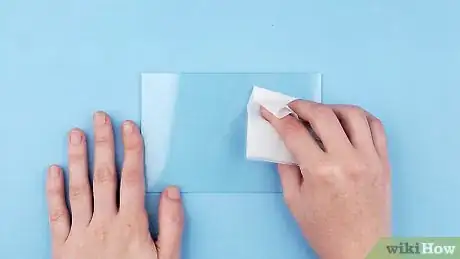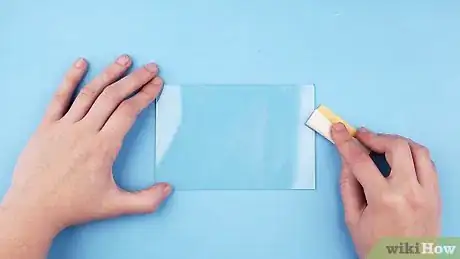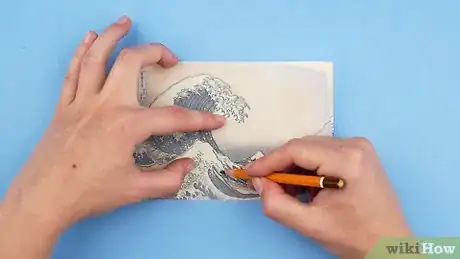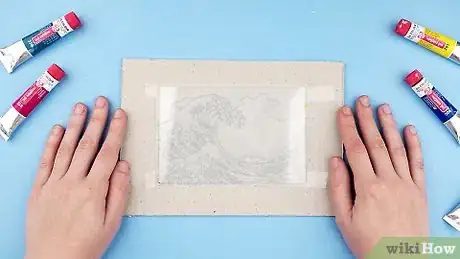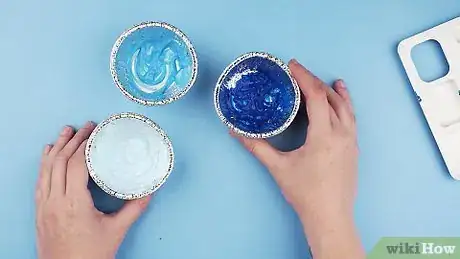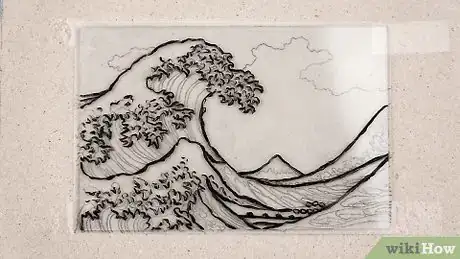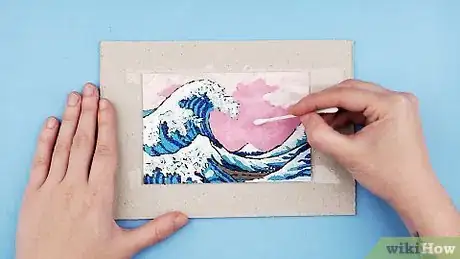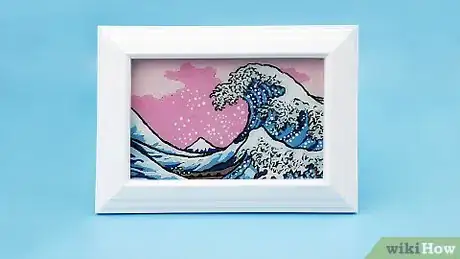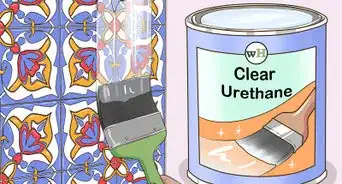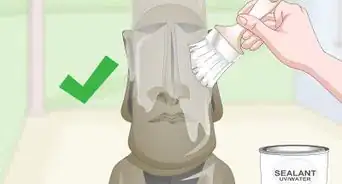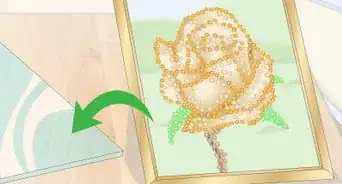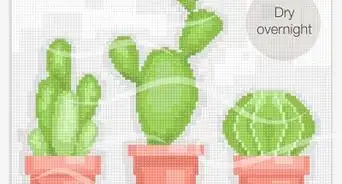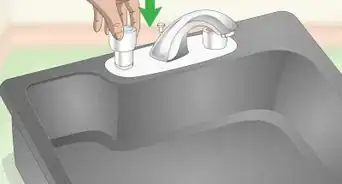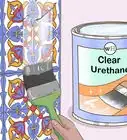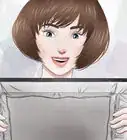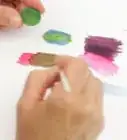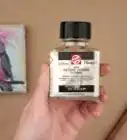This article was co-authored by Veronica Winters. Veronica Winters is a Figurative Artist who owns an online art gallery and studio in Naples, Florida. With over 20 years of experience, Veronica specializes in surreal figurative oil paintings and colored pencil drawings. In 2022, she won the Award for Distinction at the 30th Annual Colored Pencil Society of America International Exhibition. Veronica is also a published author of two art books: How to Color Like an Artist and The Colored Pencil Manual. She received her BFA in Studio Art at Oklahoma State University and her MFA in Painting at Pennsylvania State University. Veronica also studied classical drawing at the Grand Central Academy of Art and the Art Students League of New York.
This article has been viewed 156,264 times.
Reverse painting on glass is a super cool form of painting where the artist paints in reverse order on (you guessed it) glass. If you've never reverse painted on glass before and want to try it out, we've got you covered. Keep reading to learn everything you need to know to get started, from setting up your glass canvas to mixing and applying your paints.
Steps
Setting Up Your Glass Canvas
-
1Clean the sheet of glass. This glass will be your canvas for the image you want to paint. You should clean off this glass thoroughly and make sure that there aren't any scratches on it.
-
2Use fine grade sandpaper to sand the edges of the glass. This process will make the glass safe for you to handle while you're painting it and afterward. However, be careful not to scratch the glass.Advertisement
-
3Clean the glass. Use a cotton rag to thoroughly clean and rinse the glass with an abrasive cleanser and warm water. After you clean it, make sure that there are no streaks in it. If there are streaks, wash it again. When you rinse and dry the glass, it should be perfectly clear.[1]
-
4Acquire the image that you want to paint. Print it so that it is exactly the same size as your piece of glass. Trace the image onto tracing paper.
-
5Attach your image and the glass to cardboard. The cardboard will provide a sturdy base to work from. It will also prevent tracing paper from tearing.
- Use two 4-inch strips of masking tape to attach the traced image to a piece of white cardboard, larger than your glass pane. Place the strips over the top corners of the traced image.[2]
- Attach the glass to the cardboard with small (2-inch) masking tape rings on the underside of the glass, so that you do not cover your painting surface with tape. As you handle the glass, consider wearing gloves to avoid leaving oily fingerprints on the glass face.[3]
- Make sure the image is centered under the glass.
- Use white cardboard so that the lines from your image are visible and un-muddied by a dark color behind them.
-
6Slide an unmarked sheet of tracing paper between your traced image and the glass. This will prevent line doubling, when viewed from above.[4]
Mixing Paints
-
1Decide which parts of the painting you will do that day. You will need to paint in sections, allowing different areas time to dry. Drying typically takes 24 hours. For this reason, only mix colors that are needed in a specific area, to avoid having wasted, unused paint on your palette. The first colors to pour are those for line work and small detail. The last colors you will want to do are the background of the image, like the sky.
-
2Get your desired paint colors ready. You should buy oil paint; 37 ml tubes should be sufficient, unless your glass is very large.[5] If you do not have the exact paint shades that you would like for your painting, begin by mixing paints to get your desired colors.
- Squeeze the amount needed (small for a small area, more for a large area) of a light color onto palette paper, wax paper, aluminum foil, or a mixing palette. Add a small dab of the darker primary color to the light color. Mix well with a palette knife or brush. Keep adding small amounts of dark or light until you get the desired shade.
-
3Blend quick dry gilding size with the paint. Once you have the desired color/shade, add gilding size to your paint to help it adhere to the glass. Because glass is non-porous, it does not take paint well. You must use gilding size to help the paint adhere to and dry quicker on the glass.
- Pour a small amount of size directly onto your already-mixed paint and begin blending it in. Add size as needed to larger paint piles. The desired ratio is 1/2 paint to 1/2 size. Blend thoroughly with a palette knife or paint brush.[6]
-
4Pour the paint from your palette/mixing station into a small cap or cup. Separating the paints will help you avoid accidental color mixing.
Painting on the Glass
-
1Begin painting. Reverse glass paintings must be painted from front to back (reverse painting order) because of how the image is viewed through the glass.[7]
- Keep this in mind when setting up paint colors and selecting brushes. You want to start with the small details and end with the big things. It's the opposite of how you would paint a typical painting.
- Use a variety of brand-name, good quality paint brushes to avoid streaking. You can go to an art store and ask the people who work there which brushes are best for your purposes.
-
2Paint all lines first. The lines are important because they will help you fill in the rest of the painting. Try using radiography pens for extra fine line work.[8]
- Use the original image as a reference to make sure that you only paint solid lines where they should be.Sometimes, you may trace lines in an image because they indicate a color break or change, but you must remember they may not be actual solid lines.
- Once all of the lines have been painted, wait 24 hours before continuing. This will allow the paint to dry properly and avoid smudging.[9]
-
3Paint the smallest areas and details first. You want to paint the details before you paint the foreground. You want to paint the background last.
- As you paint, make sure that you avoid painting adjacent areas at the same time. If there are areas close to each other that are included in foreground but are different colors, wait for the first area you paint to dry before continuing. Placing different colors of wet paint next to each other may cause unwanted color mixture.[10]
- Allow the painted areas 24 hours to dry.
-
4Paint medium areas. Paint the medium sized areas that are larger than the detailed foreground. This is generally the main image within a painting. The “main image” should not be the small details of a painting or the background of the painting.
- Make sure that you wait 24 hours after you complete this section.
-
5Paint large areas. The last area to be painted on a reverse glass painting is the large background, such as a landscape.
- If the background is a landscape, paint grassy areas first. Allow drying time before doing sky and water.[11]
Fixing and Finishing Your Piece
-
1Fix any mistakes immediately. Because you layer the paint on top of itself, you cannot just paint over a mistake. You should take it off and fix it immediately.
- Dip an angled shader brush in lighter fluid, wipe it on a paper towel, and then brush it over the mistake. Doing this will remove unwanted paint from the glass. Carefully blot the area dry with a clean, cotton rag or allow it to air dry before reapplying paint.[12]
-
2Frame your painting. After the paint has dried, make your masterpiece eye-catching by putting it in an image-complementing frame.[13] Take the painting to a craft store for professional framing, or construct your own frame.
-
3Work at developing more advanced painting techniques. After you finish this painting, look into perfecting more advanced techniques. Once you have perfected basic “reverse order” painting, try adding depth.
- Adding the different elements of image stippling, blending, and shading to your work will make a more completed, three dimensional painting.[14]
Expert Q&A
-
QuestionWhat advice do you have for starting off an illustration when you’re using oil paints?
 Veronica WintersVeronica Winters is a Figurative Artist who owns an online art gallery and studio in Naples, Florida. With over 20 years of experience, Veronica specializes in surreal figurative oil paintings and colored pencil drawings. In 2022, she won the Award for Distinction at the 30th Annual Colored Pencil Society of America International Exhibition. Veronica is also a published author of two art books: How to Color Like an Artist and The Colored Pencil Manual. She received her BFA in Studio Art at Oklahoma State University and her MFA in Painting at Pennsylvania State University. Veronica also studied classical drawing at the Grand Central Academy of Art and the Art Students League of New York.
Veronica WintersVeronica Winters is a Figurative Artist who owns an online art gallery and studio in Naples, Florida. With over 20 years of experience, Veronica specializes in surreal figurative oil paintings and colored pencil drawings. In 2022, she won the Award for Distinction at the 30th Annual Colored Pencil Society of America International Exhibition. Veronica is also a published author of two art books: How to Color Like an Artist and The Colored Pencil Manual. She received her BFA in Studio Art at Oklahoma State University and her MFA in Painting at Pennsylvania State University. Veronica also studied classical drawing at the Grand Central Academy of Art and the Art Students League of New York.
Figurative Artist Choose a reference picture to work of that has a clear division between light and shadows. This means that you want to see strong highlights and very definite shadows. When you follow this breakdown between the light and the shadows, it's easy to paint a realistic illustration even if the colors in the reference are different from the oil paints you have.
Choose a reference picture to work of that has a clear division between light and shadows. This means that you want to see strong highlights and very definite shadows. When you follow this breakdown between the light and the shadows, it's easy to paint a realistic illustration even if the colors in the reference are different from the oil paints you have. -
QuestionWhat colors can I mix together if I want to create some gold paint for my reverse painting?
 Veronica WintersVeronica Winters is a Figurative Artist who owns an online art gallery and studio in Naples, Florida. With over 20 years of experience, Veronica specializes in surreal figurative oil paintings and colored pencil drawings. In 2022, she won the Award for Distinction at the 30th Annual Colored Pencil Society of America International Exhibition. Veronica is also a published author of two art books: How to Color Like an Artist and The Colored Pencil Manual. She received her BFA in Studio Art at Oklahoma State University and her MFA in Painting at Pennsylvania State University. Veronica also studied classical drawing at the Grand Central Academy of Art and the Art Students League of New York.
Veronica WintersVeronica Winters is a Figurative Artist who owns an online art gallery and studio in Naples, Florida. With over 20 years of experience, Veronica specializes in surreal figurative oil paintings and colored pencil drawings. In 2022, she won the Award for Distinction at the 30th Annual Colored Pencil Society of America International Exhibition. Veronica is also a published author of two art books: How to Color Like an Artist and The Colored Pencil Manual. She received her BFA in Studio Art at Oklahoma State University and her MFA in Painting at Pennsylvania State University. Veronica also studied classical drawing at the Grand Central Academy of Art and the Art Students League of New York.
Figurative Artist In general, you create gold with some brown paint—like burnt sienna, burnt umber, yellow ochre or raw sienna—and white. Add other colors, like cadmium yellows or reds, depending on how dark you want your gold tone to be. Put raw umber or ivory black into the mix to create a shadowy effect. A really nice ochre color that helps you warm up your gold tones is "gold ochre," which is sold by Gamblin Artist. It's perfect if you want a gold color in a medium tone.
In general, you create gold with some brown paint—like burnt sienna, burnt umber, yellow ochre or raw sienna—and white. Add other colors, like cadmium yellows or reds, depending on how dark you want your gold tone to be. Put raw umber or ivory black into the mix to create a shadowy effect. A really nice ochre color that helps you warm up your gold tones is "gold ochre," which is sold by Gamblin Artist. It's perfect if you want a gold color in a medium tone. -
QuestionWhat paint should I use on wine glasses?
 Community AnswerUse paint pens made for writing on glass. You can get them at the hardware store.
Community AnswerUse paint pens made for writing on glass. You can get them at the hardware store.
Warnings
- Always store glass in a safe place away from kids and pets.⧼thumbs_response⧽
- If using mercury, handle with extreme caution. It is a highly toxic element.⧼thumbs_response⧽
- Remember that when viewing a reverse glass painting from the front, the image is reversed. This is important to keep in mind if you are incorporating words.⧼thumbs_response⧽
- Maintain a dust free environment. Dust in your paints and on the glass will prevent you from having a clean looking finished product.⧼thumbs_response⧽
- Always work in a well-ventilated area. Oil paints and lighter fluid both produce toxic odors.⧼thumbs_response⧽
References
- ↑ https://books.google.com/books?id=53KRcP9DZWIC&printsec=frontcover#v=onepage&q&f=false
- ↑ https://books.google.com/books?id=53KRcP9DZWIC&printsec=frontcover#v=onepage&q&f=false
- ↑ https://books.google.com/books?id=53KRcP9DZWIC&printsec=frontcover#v=onepage&q&f=false
- ↑ https://books.google.com/books?id=53KRcP9DZWIC&printsec=frontcover#v=onepage&q&f=false
- ↑ https://books.google.com/books?id=53KRcP9DZWIC&printsec=frontcover#v=onepage&q&f=false
- ↑ https://books.google.com/books?id=53KRcP9DZWIC&printsec=frontcover#v=onepage&q&f=false
- ↑ http://link.springer.com/article/10.1007/s12520-009-0021-4
- ↑ https://books.google.com/books?id=53KRcP9DZWIC&printsec=frontcover#v=onepage&q&f=false
- ↑ https://books.google.com/books?id=53KRcP9DZWIC&printsec=frontcover#v=onepage&q&f=false
- ↑ https://books.google.com/books?id=53KRcP9DZWIC&printsec=frontcover#v=onepage&q&f=false
- ↑ https://books.google.com/books?id=53KRcP9DZWIC&printsec=frontcover#v=onepage&q&f=false
- ↑ https://books.google.com/books?id=53KRcP9DZWIC&printsec=frontcover#v=onepage&q&f=false
- ↑ https://books.google.com/books?id=53KRcP9DZWIC&printsec=frontcover#v=onepage&q&f=false
- ↑ https://books.google.com/books?id=53KRcP9DZWIC&printsec=frontcover#v=onepage&q&f=false
- ↑ https://www.britannica.com/art/painting/Techniques-and-methods
